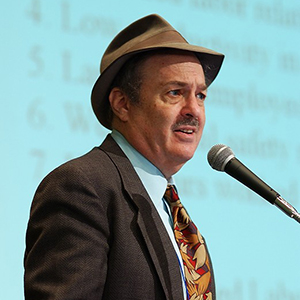Imagine you earn your living driving people around the streets of New York, or River City, or wherever. The GPS robot makes you more productive: less time needed to find addresses. Uber/Lyft technology makes you more productive: less time between riders. But then trouble comes to your city with a capital T. The driver-less car moves from experimental prototype to production and competes with you for customers.
Richard B. Freeman holds the Herbert Ascherman Chair in Economics at Harvard University. He is currently serving as faculty co-director of the Labor and Worklife Program at the Harvard Law School, and is senior research fellow in labour markets at the London School of Economics’ Centre for Economic Performance. He directs the National Bureau of Economic Research/Sloan Science Engineering Workforce Projects, and is co-director of the Harvard Center for Green Buildings and Cities.

At first driver-less cars will be very expensive and not affect you much but over time the cost of the car will fall, reducing cab fares and your income. The owner of Driver-less Cabs Inc. and the owner of Artificial-Intelligence-4-Cars and the owner of Car Sensors Inc. make money while you struggle to find work.
Now imagine you are a firefighter, who risks life and limb to save people. Into the fire station comes a robot capable of this life-threatening work. Your job changes to supervising the robot and intervening with commands in the rare situation when the robot errs, and to helping programmers re-write the computer code or machine learning algorithm so the robot makes the right decision next time—at least until a robot supervisor and self-learning algorithm takes on that job.
Not so long ago, economists and others downplayed talk of the robotization of work. The Depression Era fear among technocrats that machines would create permanent joblessness had proved false. The great automation scare of the 1960s never panned out. Most economists believed humans would never lose their advantage over machines in tasks requiring judgment and dexterity in uncertain, changing environments.
Today, the world of work is different. Robots with artificial intelligence and increased computer power undertake work traditionally done by people. Google “robot and work” or “robot and jobs’’ or “robot and employment’’ and you will find hundreds of thousands of entries. Name an occupation—yours, your spouse’s, your parents’, your kids’—and it is near certain you will find reports of improved machine technology that can make people in the field more productive with higher incomes and well-being or displace them to lower-income positions.
Surgery? Check out the newest robot headline: “Miniature Robots to Perform Surgery.” Anesthesiology? Nursing? Sales clerks? Police? Teachers? Chefs? Research assistants? Robotization has become ubiquitous in the workplace.
In my field, the invention that has begun to change work is the massive open online course (MOOC) that does what professors have traditionally done: lecture to students. MOOCs are not classical robots but videos of lectures by outstanding professors. The MOOC lecture is likely to be better than your run-of-the-mill academic lecture, cheaper for universities, and more convenient for students.
Another technology that has transformed academic work is search engines. When you have a question about almost anything, do you call an expert or hire an RA? Or do you use your Internet connection to Google the answer. If you need more details, maybe you employ a Web-scraping program or some big data algorithm. For academic research, there is already computer code, primitive but sure to improve, that develops hypotheses and ways to test them.
The key to whether we all benefit from robots at work or whether robots exacerbate the inequality of income between the super-wealthy few and the rest of society depends on who owns the robot.
The first law of a robotized labor market is that as artificial intelligence and computing power improve, robots will better substitute for human work.
The second law is that technological progress will reduce the cost of the robot substitutes over time.
The third law, a corollary of laws one and two, is that the wages of workers in occupations undergoing robotization will fall.
The implication for economic well-being is clear. Robotization of work will create a world where all of us can work less, enjoy greater leisure, and consume more and hopefully healthier products—as long as we have an ownership stake in the robots/machine technologies that will dominate future workplaces. If you own the robot taking your job, you will be better off. If I own the robot taking your job, I will be better off. Tough luck, sucker.
The implication for policy is also clear. To spread the benefits of robotization widely and prevent an inegalitarian nightmare, economic policy should seek to turn workers into the capitalist owners of the robots. The United States needs to encourage greater worker ownership in companies and in capital assets more broadly. We could:
- Improve the tax benefits for businesses with employee stock ownership programs, which currently bring ownership to 14 million Americans;
- Restrict the deductions of expenditures on profit-sharing, stock options, and other performance-related benefits to programs that cover all employees, as is the norm today for company health care and retirement programs;
- Give preference in government or business procurement to firms with some threshold level of employee ownership or profit-sharing, much as we do for small businesses or minority or female-owned businesses;
- Develop education/media programs to spread knowledge of ownership practices;
- Build extension programs, like those for farmers, to help firms with employee ownership compete in the global economy.
The choice is ours: to develop an economy in which capital/robots work for all of us or to join the robots working for the few owners.

For the Future of Work, a special project from the Center for Advanced Study in the Behavioral Sciences at Stanford University, business and labor leaders, social scientists, technology visionaries, activists, and journalists weigh in on the most consequential changes in the workplace, and what anxieties and possibilities they might produce.


